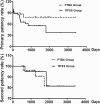Excellent long-term outcomes of endovascular treatment in budd-chiari syndrome with hepatic veins involvement: A STROBE-compliant article
- PMID: 30412110
- PMCID: PMC6221688
- DOI: 10.1097/MD.0000000000012944
Excellent long-term outcomes of endovascular treatment in budd-chiari syndrome with hepatic veins involvement: A STROBE-compliant article
Abstract
This study aimed to evaluate the long-term efficacy and safety of percutaneous transhepatic balloon angioplasty (PTBA) and transjugular intrahepatic portosystemic stent-shunt (TIPSS) in the treatment of Budd-Chiari syndrome (BCS) with hepatic veins involvement. Between June 2008 and August 2016, a total of 60 BCS patients with hepatic vein involvement in our department were enrolled in this study. Thirty-three cases underwent hepatic vein balloon angioplasty in PTBA Group and 27 cases underwent TIPSS. Data were retrospectively collected, and follow-up observations were performed. TIPSS Group showed significantly higher thrombotic/segmental obstruction and peripheral stenosis/obstruction compared with PTBA Group. The success rates were 93.9% and 100.0% in PTBA Group and TIPSS Group, respectively. The mean portal vein pressure decreased significantly after stenting. Except for 1 patient died from repeated hemorrhage, other sever complications had not been observed in both group. Twenty-six patients and 21 patients were clinically cured in PTBA Group and TIPSS Group, respectively. The primary patency rates were 89.7%, 79.3%, and 79.3% for short-term, mid-term and longterm in PTBA Group, which were significantly higher than TIPSS Group for long-term follow up. The second patency rates were 100.0%, 96.6% and 96.6% for short-term, mid-term and long-term in PTBA Group, which were similar to TIPSS Group (P = 1.0000). In conclusion, PTBA and TIPSS are safe and effective in the treatment of BCS with hepatic veins involvement, with an excellent long-term patency rate of hepatic vein and TIPSS shunt. TIPSS can be used to treat patients with all 3 hepatic veins lesion and failure PTBA.
Conflict of interest statement
The authors have no conflicts of interest to disclose.
Figures




Similar articles
-
Feasibility and midterm outcomes of percutaneous transhepatic balloon angioplasty for symptomatic Budd-Chiari syndrome secondary to hepatic venous obstruction.J Vasc Surg. 2009 Nov;50(5):1079-84. doi: 10.1016/j.jvs.2009.06.049. Epub 2009 Aug 22. J Vasc Surg. 2009. PMID: 19703746
-
Long-term safety and outcome of percutaneous transhepatic venous balloon angioplasty for Budd-Chiari syndrome.J Gastroenterol Hepatol. 2016 Jan;31(1):222-8. doi: 10.1111/jgh.13025. J Gastroenterol Hepatol. 2016. PMID: 26102208
-
Good Clinical Outcomes in Budd-Chiari Syndrome with Hepatic Vein Occlusion.Dig Dis Sci. 2016 Oct;61(10):3054-3060. doi: 10.1007/s10620-016-4208-0. Epub 2016 May 25. Dig Dis Sci. 2016. PMID: 27221497
-
Budd-Chiari syndrome in children: clinical features, percutaneous radiological intervention, and outcome.Eur J Gastroenterol Hepatol. 2014 Sep;26(9):1030-8. doi: 10.1097/MEG.0000000000000144. Eur J Gastroenterol Hepatol. 2014. PMID: 25003745 Review.
-
Budd-Chiari syndrome/hepatic venous outflow tract obstruction.Hepatol Int. 2018 Feb;12(Suppl 1):168-180. doi: 10.1007/s12072-017-9810-5. Epub 2017 Jul 6. Hepatol Int. 2018. PMID: 28685257 Review.
Cited by
-
Evaluation of outcome from endovascular therapy for Budd-Chiari syndrome: a systematic review and meta-analysis.Sci Rep. 2022 Sep 28;12(1):16166. doi: 10.1038/s41598-022-20399-x. Sci Rep. 2022. PMID: 36171454 Free PMC article.
-
Accessory hepatic vein recanalization for Budd-Chiari syndrome: a systematic review and meta-analysis.BMC Gastroenterol. 2023 Oct 2;23(1):340. doi: 10.1186/s12876-023-02969-z. BMC Gastroenterol. 2023. PMID: 37784064 Free PMC article.
-
Transjugular intrahepatic portosystemic shunt for Budd-Chiari syndrome: A comprehensive review.World J Gastroenterol. 2020 Sep 14;26(34):5060-5073. doi: 10.3748/wjg.v26.i34.5060. World J Gastroenterol. 2020. PMID: 32982109 Free PMC article. Review.
-
Establishing a jugular-femoral venous route for recanalization of complicated inferior vena cava in Budd-Chiari Syndrome after transfemoral access failure.Sci Rep. 2022 Mar 10;12(1):3903. doi: 10.1038/s41598-022-07935-5. Sci Rep. 2022. PMID: 35273255 Free PMC article.
-
Survival and clinical success of endovascular intervention in patients with Budd-Chiari syndrome: A systematic review.J Clin Imaging Sci. 2023 Jan 24;13:5. doi: 10.25259/JCIS_130_2022. eCollection 2023. J Clin Imaging Sci. 2023. PMID: 36751561 Free PMC article. Review.
References
-
- Darwish Murad S, Valla DC, de Groen PC, et al. Determinants of survival and the effect of portosystemic shunting in patients with Budd-Chiari syndrome. Hepatology 2004;39:500–8. - PubMed
-
- Okuda K. Obliterative hepatocavopathy-inferior vena cava thrombosis at its hepatic portion. Hepatobiliary Pancreat Dis Int 2002;1:499–509. - PubMed
-
- Klein AS. Management of Budd–Chiari syndrome. Liver Transpl 2006;12:S23–8. - PubMed
-
- Qiao T, Liu CJ, Liu C, et al. Interventional endovascular treatment for Budd–Chiari syndrome with long-term follow-up. Swiss Med Wkly 2005;135:318–26. - PubMed
Publication types
MeSH terms
Substances
LinkOut - more resources
Full Text Sources

